#1917 German pilot
Text


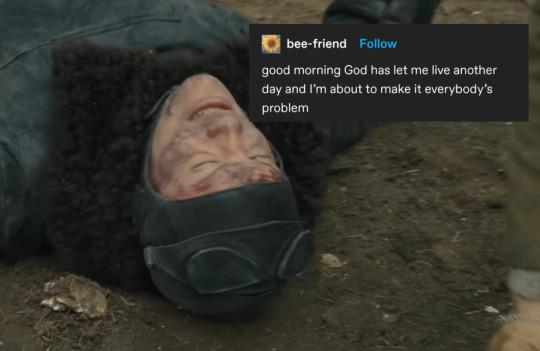
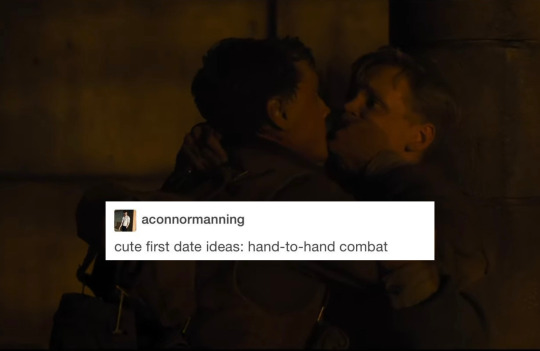
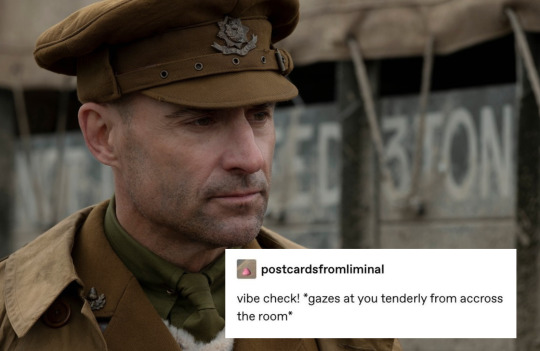
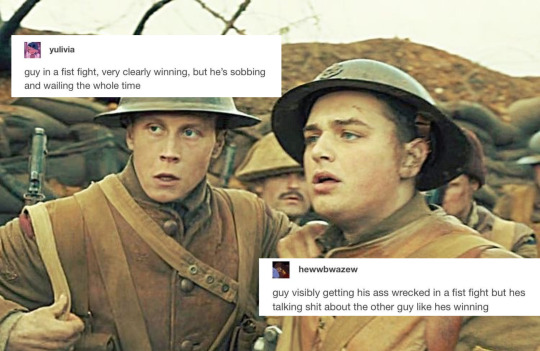

1917 + text posts, part 3
(Part 1) (Part 2)
#1917 movie#1917#1917 film#1917 (2019)#will schofield#tom blake#Captain smith#1917 captain smith#1917 German pilot#general erinmore#1917 baumer#friedrich baumer#source: tumblr
246 notes
·
View notes
Text
As the name suggests, the World Wars involved the world. People from all over served, and this includes people from African and Carribbean countries, yet I feel they are not so well-remembered in media and the history books for their heroics and sacrifices. Here are a few icons among many below.
Eugene Bullard

Eugene Jacques Bullard (1895-1961) was one of the first black American pilots and served in the French air force’s Lafayette Flying Corps, an all-American volunteer outfit, in World War 1. Meanwhile, in World War 2, Eugene Bullard served as a spy for France, where he also proved highly successful against the Nazi regime. Bullard was fluent in English, German and French, as well as a boxer and self-taught Jazz musician.
Eugene Bullard was awarded fifteen French war medals: Knight of the Légion d’honneur, Médaille Militaire, Croix de Guerre, Volunteer’s Cross (Croix du combattant volontaire), Wounded Insignia, World War I Commemorative Medal, World War I Victory Medal, Freedom Medal, and the World War II Commemorative Medal.
Walter Tull

Lieutenant Walter Tull (1888 - 1918) was the first British-born black army officer and the first black officer to lead white British troops into battle. He fought on the Somme in 1916 and became the first black combat officer in the British army in spite of a military rule officially excluding "any negro or person of colour” from that position. Before the War, he was a pioneering black football player and the first black outfield player to feature in the English top flight, with two seasons at Tottenham Hotspur.
Sadly, Walter Tull was killed in 1918, during the early German spring offensive, and was never awarded the military cross that he was recommended for.
Johnny Smythe

Born in Sierra Leone, Johnny Smythe (1915 - 1996) successfully made it into RAF aircrew during the Second World War. Smythe trained as a navigator, having a great talent for mathematics. He successfully navigated 26 bombing missions over Germany, although was unfortunately shot down on his 27th mission and captured. Smythe would spent the last two years of the war in Stalag Luft I, an infamous Lufftwaffe-run POW camp, until he was liberated by the Russians in 1945.
In 1948, Johnny Smythe served as the senior officer aboard the Windrush. After pursuing a career in law and working as the Queen's Counsel for Sierra Leone for a number of years, in 1961 he was appointed Solicitor General of the newly independent Republic of Sierra Leone. In 1978, he awarded the Order of the British Empire (OBE) for his outstanding service.
Ulric Cross

Ulric Cross (1917 - 2013) was Trinidadian and one of the most decorated Caribbean airmen in WWII. Joining the RAF at 24, he trained as a navigator and joined 139 Squadron, gaining the nickname ‘The Black Hornet’. Cross was an expert in precision bombing and later joined the ranks of the elite Pathfinder Force, flying high-risk missions into enemy territory as low as 50 feet as opposed to 25,000 like most pilots. While Cross was offered the option to rest after completing 50 missions, he instead volunteered for another 30 missions over enemy territory. At the end of the War, Cross had flown a total of 80 missions.
For his undeniable commitment, hard work and skill, Cross was awarded the Distinguished Flying Cross and the Distinguished Service Order.
#world war 2#world war 1#us history#uk history#africa#sierra leone#trinidad#black soldiers#world war means WORLD War#someone write a movie about these guys and many others#history#black history#caribbean
160 notes
·
View notes
Text
Rudolf Hess during WWI
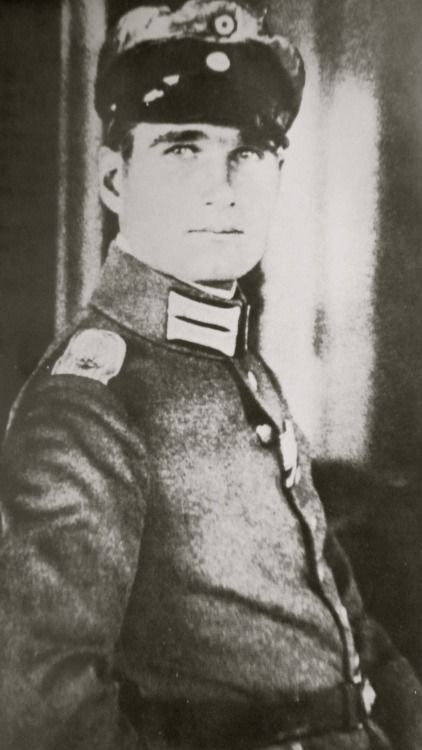
These are some facts and curiosities about Rudolf Hess during WW1:
He enlisted as an infantryman in the Imperial German Army at the outbreak of World War I.
His initial posting was against the British on the Somme; he was present at the First Battle of Ypres.
He was wounded on 23 July and again on 8 August 1917; the first injury was a shell splinter to the left arm, which was dressed in the field, but the second was a bullet wound that entered the upper chest near the armpit and exited near his spinal column, leaving a pea-sized entry wound and a cherry stone-sized exit wound on his back.
While still convalescing, Hess had requested that he be allowed to enroll to train as a pilot. By 14 October he had been assigned to Jagdstaffel 35b,
He saw no action with Jagdstaffel 35b, as the war ended on 11 November 1918, before he had the opportunity
In October 1918 he received promotion to Leutnant der Reserve and was recommended for, but did not receive, the Iron Cross, first class.
Sources:
Military Wiki: Rudolf Hess
Wikipedia: Rudolf Hess
I DON'T SUPPORT NAZISM,FASCISM OR ZIONISM IN ANY WAY, THIS IS AN EDUCATIONAL POST
50 notes
·
View notes
Text

remember when i promised you (friends, romans, countrymen) a male raf mota oc? here he is!
Full name: Edwin Denholm “Ed” Townes
Age: 26 (as of May 1943)
Date of birth: 21 January 1917
Hometown: Bournemouth, Southeast Dorset, England
Occupation: Fighter pilot (1939–1940); Lancaster heavy bomber pilot
Affiliation: No. 242 Squadron, RAF (1939–1940); No. 635 Squadron, No. 8 Group RAF, Bomber Command
Rank: Squadron Leader (OF-3)
Service number: 41977
Aircraft: Hawker Hurricane Mk I; Supermarine Spitfire Mk. IX; Avro Lancaster Mk.III
Personality: ISTJ 1w9
Premise: Squadron Leader Edwin Townes is one of the RAF officers encountered by the boys of the 100th in the Norfolk pub they frequent. A veteran from the Battle of Britain and the third leading ace of his wing with 9 aerial victories, Townes spent the majority of his career – which he was told would be promising after having graduated from King’s College London and RAF College Cranwell back-to-back before the start of the Second World War – defending his homeland from the Luftwaffe’s mass air attacks in the Blitz as a fighter pilot. Presently, he flies Lancasters on night-bombing raids against German industrial targets. Like most British pilots who have remained operational since the start of the war, he’s lost wingmen, squadmates and members of his bomber crew. And the last thing he’s interested in is an American trying to lecture him about the vices of night raids and the perceived tactical mistakes made by Bomber Command.
He’s not the kind of officer who’s going to let them get away with it either. Straightforward, pragmatic, decisive and ever-dependable, Ed Townes is experienced in the sky and capable of remaining calm under endless barrages of enemy gunfire and 88mm flak all while directing his crew to safety. Growing up as the eldest brother in a family of five has instilled in him from a young age a strong sense of duty. He’s fought in this war for four long years already. He’s going to get through the rest of it and make it back home to Bournemouth—even if the bloody Yanks seem to be trying their best to ensure the opposite outcome.
39 notes
·
View notes
Text

1917 10 The golden triumvirate - Russell Smith
repost better resolution
Among the German Jastas, one of the highest scoring was Jasta 5, with over 250 victories to its credit. Three of its most notable pilots – Ltn d R Fritz Rumey, Ltn d R Josef Mai and Ltn d R Otto Könnecke – gained such a notable reputation that they acquired the nickname “The Golden Triumvirate.” Between them, these three non-commissioned officers scored 110 victories by the war’s end. Like all other German Jastas, Jasta 5 was based at several different aerodromes during the war. However, the unit is usually associated with with the Boistrancourt aerodrome, shown here. Boistrancourt was notable in that it was one of the only German Aerodromes to have hard, fixed hangars rather than the canvas tent hangars which were normally utilized. Behind the aerodrome was a chateau and a sugar refinery which added to its distinctive look.Pictured from front to back are: Ltn d R Josef Mai, 30 victories; Ltn d R Otto Könnecke, 35 victories; Ltn d R Fritz Rumey, 45 victories.
53 notes
·
View notes
Text
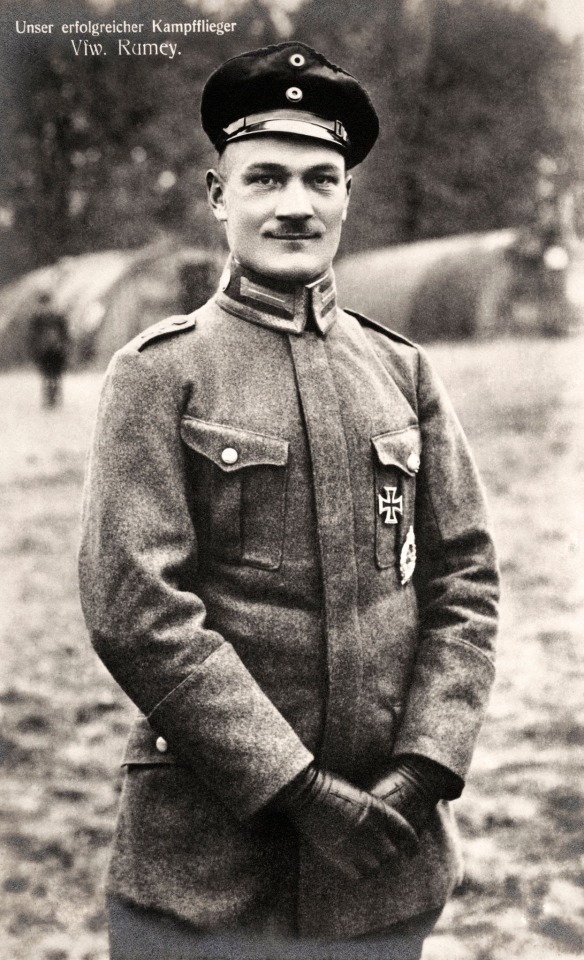
45 victory ace and Pour le Mérite (Blue Max) holder, Vizefeldwebel Fritz Rumey. When the war began, Rumey was serving with the 45th Infantry Regiment. After serving with the 3rd Grenadier Regiment on the Russian Front, he transferred to the German Air Force in the summer of 1915. Serving first as an observer with FA(A) 219, he completed Jastaschule and was assigned to Jasta 2 in May 1917. The following month, he joined Jasta 5. He was wounded in action on 25.8.1917 and again on 24.9.1917. He was a scoring machine of a pilot, shooting down 40 aircraft in nine months of 1918, including 16 in September alone. In his last dogfight, Rumey's Fokker D.VII was badly damaged when he collided with an S.E.5a flown by South African ace George Lawson. Rumey jumped from his plane but was KIA on 27.9.18 when his parachute failed to open. For more, see my Facebook group - Eagles Of The Reich
13 notes
·
View notes
Note
I have a few questions,
1. Had Hercules ever served in the navy or marines?
2. What is the symbol on captain stars eyepatch and will you touch on how he lost his eye or arm?
3.can you give us the ages of the stars and zeros from oldest to youngest?
4. Do you plan on drawing the side characters of tugs such as Lillie lightship, scuttlebutt Pete or big Mickey?
1. hercules has never served in the navy. if you're looking at his hat, it was just a simple white hat with a blue band and black visor. he slightly modified it so it resembles captain star's. he was younger and used to look up to him highly. though as time passes, he slowly regrets it because of how time and time again it was proven the the navy is a blight on bigg city port and that captain star may not be as trustworthy as hercules made him out to be
2. the symbol on captain star's eyepatch is an anchor, tilted 45 degrees!
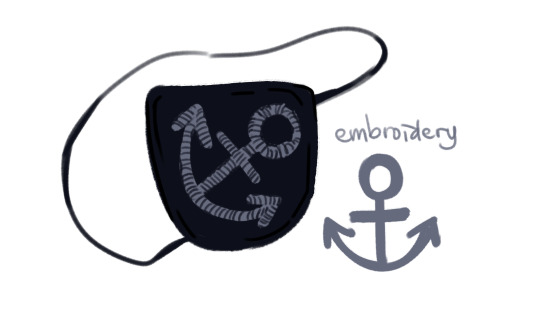
captain star is a world war I veteran. as soon as the united states stepped down from its neutral position in the war (selective service act of 1917, the sinking of rms lusitania in 1915), captain star was sent to the british grand fleet to help out the allied powers. since the usa military joined in late, they didn't have any big encounters with the central powers, only ones with german u-boats in relation to the us navy.
during the atlantic ocean blockade efforts in late 1917 to early 1918, captain star lost his left arm from an explosion while he lost his right eye during a brief surface engagement with german troops who were piloting a u-boat in which one of them shot him in the eye.
3. here's their age list:
Captain Archibald Star: 54
Thomas “Ten Cents” Haddock: 18
Graham MacLachlan “Big Mac”: 38
David “OJ” Jones: 62
Hwang Dong-Ha “Top Hat”: 27
Benjamin “Warrior” Guttierez: 24
Herkules “Hercules” Simarmata: 32
Samuel “Sunshine” Madison: 18
Ravikumar “Grampus” Shankar: 35
Captain Maximus Zero: 54
Giuseppe “Zorran” vin Diesel: 31
Ismail “Zebedee” Saifullah: 36
Zakheus “Zak” Miller: 34
Jürgen “Zug” Mikelsaar: 26
Zip: 18
4. I do plan on drawing them someday! I already have a design for lillie in mind, but I'm currently more focused on drawing stuff related to the two fleets right now!
25 notes
·
View notes
Text
In honor of Black History Month, here are 10 Black Americans who were pioneers of their time. (I apologize that this post is late. I’ve been preoccupied with midterm exams)
Eugene Bullard (1895 - 1961)
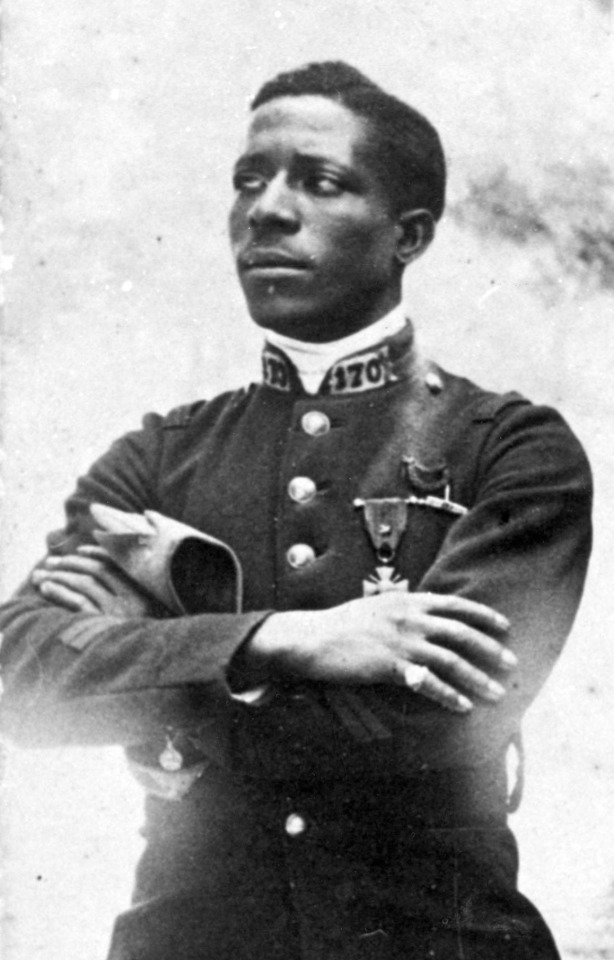
Eugene Bullard was one of the first African American military pilots in the world. Originally from Georgia, Bullard had run away from home when he was 11 and wondered around the state for six years with a clan of gypsies before stowing away on a German cargo ship in 1912. He ended up in Aberdeen, Scotland and eventually ended up in London, where he worked as a boxer and performer for an entertainment troupe. He traveled to Paris for a boxing match and eventually settled there permanently. When World War 1 began in 1914, Bullard joined the French Foreign Legion, where he saw combat at the Somme, Champaign, and Verdun. After being injured during the Battle of Verdun, he was sent to Lyon to recuperate. After recovering in 1916 he joined the French Air Service as a machine gunner. He obtained his pilot's license in 1917. He flew several missions during the war and claimed two victories over German planes. He applied to join the American Air Corps after the United States entered the war in 1917 but was rejected because of his race. Bullard returned to the French Air Service but was removed after an apparent conflict with a French officer. He remained in the military until 1919. He returned to Paris where he worked a nightclub, operated his own nightclub and gym, and married Marcelle de Straumann. After Germany invaded France in 1940, he volunteered to fight again, but was injured during the defense of Orleans. He escaped to Spain and later returned to the United States, settling in Harlem, New York City. In 1949, he was working as a security guard at concert hosted by Paul Robeson. Riots broke out where a racist mob and police officers beat concert goers, including Bullard. He eventually died of Stomach Cancer in 1961.
Bullard received many honors from France. In 1954, the French government invited Bullard to Paris to be one of the three men chosen to rekindle the everlasting flame at the Tomb of the Unkown Soldier under the Arc de Triomphe. In 1959, he was made a Knight of the National Order of the Legion of Honor. He also received the Military Medal, an award given for courageous acts and the third highest award in France. After his death, he also received honors from the United States. He was posthumously commissioned as a Second Lieutenant in the United States Air Force in 1994. He was inducted into the Georgia Aviation Hall of Fame in 1989 and the National Aviation Hall of Fame in 2022. The Museum of Aviation in Warner Robbins, Georgia erected a statute in honor of Bullard.
Ruby Bridges (1954 - )

Ruby Bridges hadn't even been born yet when, in 1954, the United States Supreme Court made a landmark ruling in the Board vs. Board of Education case that declared that desegregation in public schools was unconstitutional. This decision caused protests and celebrations all across the South, including New Orleans, Louisiana. In 1960, when Ruby was 6 years old, U.S. Circuit Court Judge ruled that schools in New Orleans must begin desegregation. Ruby was one of four 6-year-old girls (the others being Lenona Tate, Tessie Provost, and Gail Etienne) selected by the NAACP to participate in the integration. Tate, Provost, and Etienne enrolled at McDonogh 19 Elementary School, while Bridges enrolled at William Frantz Elementary School. All four faced death threats, racial slurs, and taunts. After a race riot broke out at Parish School Board meeting, U.S. Marshalls were called in to escort the girls to and from school.
Since the tumultuous period, Bridges has become a symbol of the Civil Rights Movement. She has been the subject of Songs, documentaries, movies, and 1964 Norman Rockwell painting "The Problem We All Live With". She is currently the Chair of the Ruby Bridges Foundation. She has also received numerous accolades over her life including the Presidential Citizens Medal by President Clinton in 2001, being honored as a "Hero Against Racism" by the Anti-Defamation League in 2006 and being inducted in the National Women's Hall of Fame in 2024.
Bessie Coleman (1892 - 1926)

Bessie Coleman was born the tenth child out of thirteen to a family of sharecroppers in Texas. She walked four miles each day to attend a segregated school where she loved reading and established herself as an exceptional math student. Every harvest season she helped her family harvest cotton. When was turned eighteen years old, she enrolled at the Oklahoma Colored Agricultural and Normal University in Langston, Oklahoma (known today as Langston University). She only completed one term before running out of funds and returning home. In 1915, she moved to Chicago to live with brothers where she worked as a manicurist at a barbershop, where she heard flying stories of pilots returning from their service in World War 1. She took a second job as a restaurant manager to save money in the hopes of becoming a pilot herself, but flight schools in the U.S. at the time were not accepting women nor black people. As such, she was encouraged to study abroad by Robert Abbott, publisher of the African American newspaper 'The Chicago Defender'. To do this she received financial backing from the defender and banker Jesse Binga (founder of the first black owned bank in Chicago).
In 1920, she traveled to France to earn her license. She trained on a Nieuport 14 Biplane. In 1921, she received her pilots license, becoming the first black woman (and first black person in general) to receive a license from the Fédération Aéronautique Internationale. She returned to the United States in September becoming a media sensation. She made a living performing in air shows as a stunt flier. She met with community activists and spoke before crowds about perusing aviation as a profession and the goals of black people in the United States. Unfortunately, she was killed in 1926, when the plane she was flying in lost control and threw her out at 2,000ft. Though she never established her own flight school, her ambitions inspired many other black aviators to this very day.
Katherine Johnson (1918 - 2020)
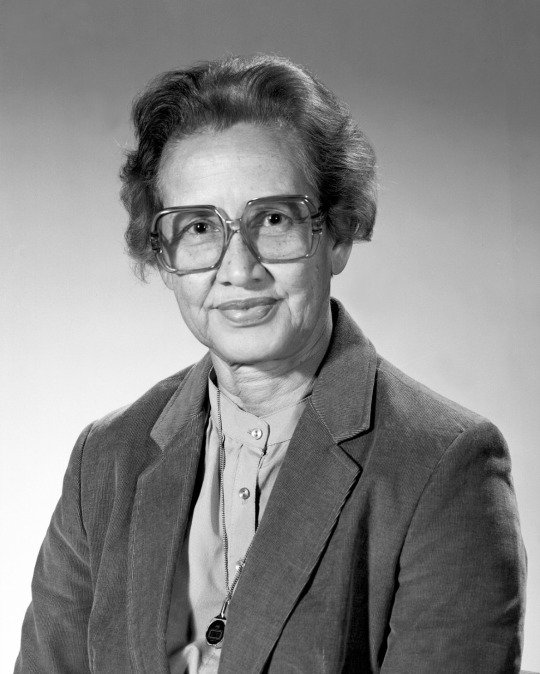
Katherine Johnson was one of the first black to be employed as a scientist at the National Aeronautics and Space Administration. Born in White Sulpher Springs, West Virginia, she was the youngest of four children. Her mother was a teacher, and her father was a lumberjack, farmer, and handyman. From an early age she displayed strong mathematical abilities, so her parents enrolled her in high school in Institute since their home county didn't school for African Americans passed the 8th grade. After graduating high school, she enrolled at West Virginia State College, where took every mathematics course offered (new classes were even added just for her). She graduated 'summa cum laude' in 1937 and took a teaching job Marion, Virginia.
In 1938, the Supreme Court ruled that states that provide higher education for white students must provide it for black students as well. As a result of this, Johnson was selected along with two men to become the first black students to be enrolled at the West Virginia University Graduate School in 1939. However, she left the program to start a family with her husband James Goble. The couple had three daughters: Joylette, Katherine, and Constance.
At a family gathering in 1952, a relative informed her that the National Advisory Committee for Aeronautics (NACA, the precursor to NASA) was hiring mathematicians and that the Langley Research Center was hiring Black applicants as well as white. Johnson took a job at the agency in 1953. She spent 33 years with NACA and NASA, where she earned a reputation as a human computer for mastering complex mathematical calculations and helping pioneer the use of electronic computers. She worked at topics including gust alleviation, flight trajectories, and launch windows. Her work was instrumental to the Apollo Missions during the Cold War 'Space Race'. For her work she was awarded the Presidential Medal of Freedom in 2015, the Silver Snoopy Award and a NASA Group Achievement Award in 2016, and the Congressional Gold Medal in 2019. She was the one of the subjects of the 2016 film Hidden Figures, and she was posthumously inducted into the National Womens Hall of Fame in 2021.
Shirley Chisholm (1924 - 2005)

Shirley Chisholm was the first black woman to be elected to the United States Congress. She was born in Brooklyn to working class parents. Since her mother face difficulty working and raising her children, Shirley and her three younger sisters were to live with their grandmother in Barbados. She said about her grandmother "Granny gave me strength, dignity, and love. I learned from an early age that I was somebody. I didn't need the black revolution to teach me that". She returned to the United States in 1934 and in 1939, began attending the integrated Girl's High School in Brooklyn. She did so well academically, she served as the Vice President of the Junior Arista Honor Society. She attended Brooklyn College where she majored in sociology and graduated in 1946. She married her husband Conrad in 1949. After suffering two miscarriages, the couple learned they could not have children. She worked as a teacher's aide from 1946 to 1953, during which she went on to obtain her master's degree in childhood education from Columbia University in 1951. She soon became an authority on childhood education and child welfare as a consultant for the Division of Day Care in New York City's Bureau of Child Welfare.
She entered politics when she joined the effort to elect Lewis Flagg Jr. to the bench as the first black judge in Brooklyn. The election group became known as the Bedford–Stuyvesant Political League (BSPL), which pushed candidates that supported civil rights and advocated for expanding opportunities in Brooklyn. After leaving the BSPL she worked with a number of different political groups including the League of Women Voters, the National Association for the Advancement of Colored People (NAACP), the Urban League, and the Democratic Party Club in Bedford-Stuyvesant, Brooklyn.
In 1964, Chisholm decided to run for the New York State Assembly after the present holder, Thomas R. Jones, was appointed to the New York City Civil Court. Despite resistance because she was a woman, she appealed to women voters and won the Democratic primary in June. She was elected in December serving in the assembly from 1965 to 1968, where she championed several pieces of legislation including expanding unemployment benefits and sponsoring the introduction of the SEEK program which helped disadvantaged kids enter college. In 1968 Chisholm ran for the United States House of Representatives for New Yorks 12th District, which had recently been redrawn to incorporate the Bedford-Stuyvesant neighborhood. She ran with the slogan "unbought and unbossed" and won the district with a nearly 2 to 1 margin over her opponent, becoming the first black woman ever elected to Congress. She served on a number of different committees during her career, including the Agriculture, Veterans, and Education and Labor Committees. She worked with Bob Dole to expand the Food Stamps program, played a critical role in the creation of the WIC program, and was a founding member of the Congressional Black Caucus and the National Women's Political Caucus. In 1972, she became the first black candidate for a major-party nomination for President of the United States and the first woman to run for the Democratic Party's presidential nomination, though she ultimately lost the nomination. She retired from politics in 1983, after 14 in Congress. She was posthumously awarded the Presidential Medal of Freedom in 2015.
Thurgood Marshall (1908 - 1993)

Thurgood Marshall was a lawyer and jurist who served as the black justice of the United States Supreme Court. Marshall was originally from Baltimore, Maryland, where graduated from high school with honors in 1925 and then attended Lincoln University in Pennsylvania where he graduated with honors in 1930 with a bachelor's degree in American literature and philosophy. While at Lincoln, he led the schools debate team to numerous victories. He attended Howard University Law School in Washington, D.C. because he couldn't attend the all-white University of Maryland Law School. While at Howard, he was mentored by NAACP first special counsel and Law School Dean George Hamilton Houston. He graduated first in class in 1933. He joined Houston as his assistant at the NAACP in 1935, where they worked together on the landmark case Missouri ex rel. Gaines vs. Canada, which ruled that any state which provides a school to white students had to provide in-state education to black students as well. After Houston returned to Washington, Marshall took over his position as special counsel to the NAACP and also became director-counsel of the NAACP Legal Defense and Educational Fund Inc.
During his career he argued 32 civil rights before the Supreme Court, winning 29 of them. Many of them were landmark cases including Smith vs. Allwright (which ruled that primary elections must be open to voters of all races), Morgan vs. Virginia (which ruled that a state law enforcing the segregation of interstate buses was unconstitutional), Shelley vs. Kramer (which ruled that racially restrictive housing covenants cannot be legally enforced), and Brown vs. Board of Education (which ruled that state laws requiring segregation in schools was unconstitutional).
In 1961, President John F. Kennedy appointed him as a judge on the United States Court of Appeals for the Second Circuit in order for Kennedy to demonstrate his commitment to the interests of black Americans. He took the oath after numerous delays by southern Senators. Marshall authored 98 majority opinions while on the bench. He was nominated as the United States Solicitor General by President Lyndon B. Johnson in 1965, where he won fourteen of the nineteen Supreme Court cases he argued. In 1967, Johnson nominated Marshall to be a Supreme Court Justice after Justice Tom C. Cark resigned. He took the Oath of Office on October 2. Marshall remained on the Court for 24 years until his retirement in 1991. A staunch liberal, he often dissented from the court as the liberal majority vanished and the court became more conservative. During his tenure he advocated for equal rights for minorities, opposed the death penalty, and supported abortion rights.
Jesse Owens (1913 - 1980)

Jesse Owens was an American track and field athlete who won four gold medals at the 1936 Summer Olympic Games. Owens was born the youngest of ten children in Oakville, Alabama. In 1922, his family moved to Ohio during the great migration in search of better opportunities. As a child, he developed a passion for running, which was encouraged by his middle school track coach Charles Riley. It was in middle school where he met Minnie Solomon. They married in 1935 and had three daughters: Gloria in 1932, Marlene in 1937, and Beverly in 1940. He first came to national attention while attending high school where he equaled the world record of 9.4 seconds in the 100 yards dash and long-jumped 24 feet 91⁄2 inches at the 1933 National High School Championship in Chicago. While a student at Ohio State University, Owens won a record eight NCAA championships. Notably in 1935, he set three world records and tied a fourth during the Big Ten Conference track meet in Ann Arbor. He equaled the world record of 9.4 seconds in the 100-yard dash and set records for the long jump at 26 feet 81⁄4 inches, the 220-yard sprint at 20.3 seconds, and the 220-yard low hurdles at 22.6 seconds, which cemented him in track and field history.
In 1936, in despite of his apprehension, he was selected to compete in the Summer Olympics in Berlin, Germany. At the time, Germany was under the iron grip of the Nazi regime led by Adolf Hitler. Hitler saw the games as an opportunity to promote the Nazi ideals of antisemitism and Aryan supremacy. He believed German athletes would dominate the games. However, he visions went unfulfilled. Over the length of competition Owens won Gold Medals in the 100-meter dash at 10.3 seconds, the long jump at 26 ft 5 inches, the 200-meter sprint at 20.7 seconds, and the 4 x 100-meter sprint relay at 39.8 seconds. On August 1, Hitler shook hands with the German victors only and left the stadium and then skipped all further medal presentations. Despite his victories, racial discrimination in the United States made it difficult for Owens to earn a living, being prohibited from appearing at sporting events and refused commercial sponsorships. He attempted several careers, but all they proved fruitless. He hit rock bottom in 1966, when he was prosecuted for tax evasion. In 1955, President Dwight D. Eisenhower selected Owens as a Goodwill Ambassador, being sent all around the world to promote physical exercise and tout American freedom and economic opportunity in the developing world, a position held until the 1970s. He also did product endorsement for corporations such as Quaker Oats, Sears and Roebuck, and Johnson & Johnson. He was invited to the 1972 Munich Summer Olympics as a guest of the West German government. He eventually retired and moved to Arizona with his wife. Owens succumbed to Lung Cancer in 1980 at the age of 66 and was buried in Tucson, Arizona. In 1983 he was inducted into the U.S. Olympic Hall of Fame and was posthumously a Congressional Gold Medal in 1990.
Hiram Revels (1827 - 1901)
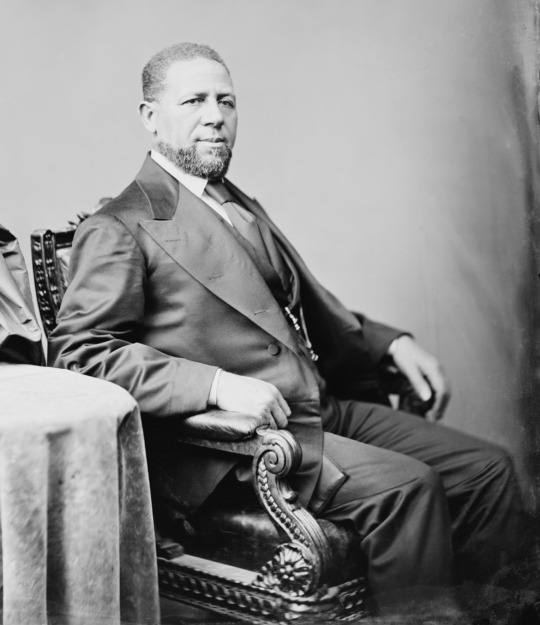
Hiram Revels was the first African-Amercian to serve in the United States Congress. He was born to free black people in Fayetteville, North Carolina. His father was a Baptist preacher. He attended a Quaker seminary in Indiana as a boy and in 1845, was ordained as a minister with the African Methodist Episcopal Church. He traveled throughout the Midwest preaching and acted as a religious teacher. He studied religion at Knox College in Illinois from 1855 to 1857 and then became a minister a Methodist Episcopal Church in Baltimore, Maryland, while also serving as a high school principal. During the Civil War, he enlisted as a Chaplain in the Union Army and helped recruit and organized two black regiments in Maryland and Missouri.
In 1866, Revels was called to be the pastor in Natchez, Mississippi where he settled permanently with his wife and five daughters. In 1868, during the Reconstruction Era, he was elected as an Alderman of Natchez and in 1869, he was elected to represent Adams County in the Mississippi State Legislature. In 1870, Revels was elected to the United States Senate by the state legislature to fill the seat left since before the Civil War. Southern Democrats opposed his seat, stating that the 1857 Dred Scott decision disqualified him on basis if citizenship. He officially became the first black senator on February 25. As a senator, he advocated compromise and moderation, and supported racial equality. He served on both the Committee of Education and Labor and the Committee of the District of Columbia (at the time, Congress administered the district). His professional conduct was greatly admired by fellow congressmen and the Northern press. After his term expired, he became President of Alcorn Agricultural and Mechanical College in Claiborne County, Mississippi (currently Alcorn State University). He served in this post until his retirement in 1882. In 2002, he was listed as one of 100 Greatest African Americans by Molefi Kete Asante.
Henry Johnson (1897 - 1929)
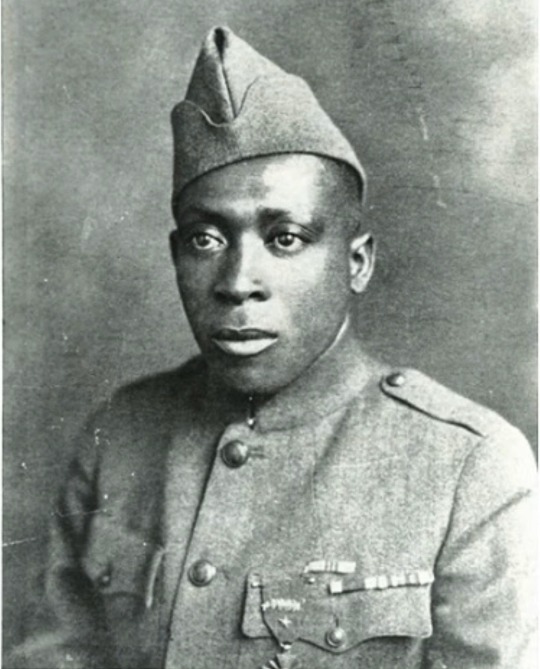
Henry Johnson was an American soldier who was noted for heroic actions during World War One. Originally from North Carolina, he moved to Albany, New York and worked variety of menial jobs before enlisting in the army in 1917, two months after the United States entry into the First World War. The unit he was assigned to, the all-black New York National Guard 15th Infantry Regiment, was mustered into federal service and redesignated as the 369th Infantry Regiment, commonly known as the Harlem Hellfighters. The regiment was assigned to labor service duties while stationed in Europe. The black service members faced discrimination and harassment by white soldiers and even the American headquarters. The American commander loaned the regiment to the French Army. It's believed he did this because white soldiers refused to fight alongside black soldiers. The French enthusiastically welcomed the new troops.
The regiment, Johnson included, was assigned to the Ardennes Forest. While on outpost duty on the night of May 14, 1918, Johnson came under attack by a German raiding party. Using only his bare hands, a bolo knife, his rifle butt, and some grenades, he was able to repel the attackers, killing four of them and preventing the capture of his fellow soldiers, all while suffering 21 wounds. He was given the nickname "Black Death" for his actions and awarded the Croix de guerre by France. However, his actions went unrecognized in the U.S. because of racial discrimination, and he died poor and in obscurity. However, he has since been posthumously given several awards by the military, including the Purple Heart in 1996, the Distinguished Service Cross in 2002, and the Medal of Honor in 2015. In 2023, the U.S. Army base Fort Polk in Louisiana was renamed Fort Johnson in his honor.
Dorothy Height (1912 - 2010)
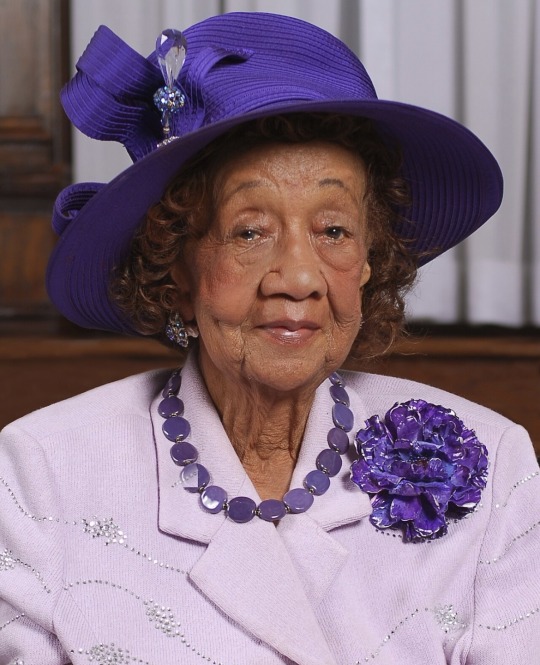
Dorothy Height was an activist for both the Civil Rights and Women's Rights movements. Height was born in Richmond, Virginia and moved to Rankin, Pennsylvania when she was five. Her mother was active in the Pennsylvania Federation of Colored Women's Clubs, and regularly took along Dororthy to meetings, which exposed her to activism from a young age. Height was an enthusiastic participate in Young Women's Christian Association, who was eventually elected as president of the club. She was appalled to learn that her race prevented her from using the YMWA's central branch swimming pool and dedicated much energy to changing the YWCA. While in high school she was active in the anti-lynching movement and won first place and a $1,000 scholarship in a national oratory contest held by the Elks Club. Height graduated from high school in 1929 and was accepted entry in Bernard College at Columbia University but was barred from entering because the school had an unwritten policy of only admitting two black students a year. She instead enrolled at New York University and graduated with a bachelor's degree in 1932 and a master's degree in educational psychology in 1933. She pursued postgraduate work at the New York School of Social Work.
From 1934 to 1937, Height worked for the New York Department of Welfare, a job she credited for teaching her conflict resolution skills. She then took a job as a counselor at the YWCA Harlem Branch. While working there she met civil rights activist Mary McLeod Bethune and First Lady Eleanor Roosevelt at a meeting of the National Council of Negro Women being held at the YWCA office. During this meeting Bethune told her "The freedom gates are half ajar. We must pry them fully open". She dedicated her life to this cause. She also did work with the United Christian Youth Movement, a group that worked to relate faith to real-world problems.
Beginning in 1939, she worked at YWCA offices in New York City and Washington, D.C., specializing in interracial relations. She ran trainings, wrote periodicals, and worked in Public Affairs on race issues. She believed that segregation caused prejudice through estrangement, so after the YWCA adopted in interracial charter in 1946, Height worked to help white members of the organization transcend their apprehension and bring their action in line with what the YWCA principles by running workshops, facilitating meetings, and writing articles. In 1958, she was elected president of the National Council of Negro Women and remained at the post until 1990. While president of the NCNW, she worked alongside civil rights leaders such as Martin Luther King Jr., John Lewis, and Whitney Young. Thanks to her background as an orator, she became a master at acting as the middleman in initiating dialogue between feuding parties. In 1963 she became head of the "Action Program for Integration and Desegregation of Community YWCAs", which was started in response to the growing civil rights movement. In this role she worked to monitor progress in integrating the association. In 1974, she was named to the National Commission for the Protection of Human Subjects of Biomedical and Behavioral Research, which was formed in response to the Tuskegee Syphilis Experiment scandal. She was also a driving force behind the movement to get a statue of Mary McLeod Bethune in Lincoln Park, the first statue of a woman or a black person to be erected on federal land.
She was inducted into the National Women's Hall of Fame in 1993. She was awarded the Presidential Citizen's Medal in 1989, the Presidential Medal of Freedom by President Bill Clinton in 1994, a Congressional Gold Medal by President George H.W. Bush in 2004, and President Barack Obama called Height "the godmother of the civil rights movement and a hero to so many Americans". She died on April 20, 2010, at the age of 98. She was buried at Fort Lincoln Cemetery in Maryland after a funeral at the National Cathedral in Washington D.C. She is considered one of the driving forces of the American Civil Rights Movement.
10 notes
·
View notes
Text
In 1917, two Royal Corp pilots on patrol over France got attacked by Germans in World War I. Alexander Mackaye thought he was done for when his wing man flew into a cloud and actually disappeared. In actuality, the other pilot was transferred 42 years into the future. ("The Last Flight", Twilight Zone, TV, Event)

#nerds yearbook#1917#wwi#world war i#dog fight#tz#twilight zone#richard matheson#rod serling#william f claxton#kenneth haigh#alexander scourby#simon scott#robert warwick#harry raybould#jerry catron#paul baxley#jack perkins
6 notes
·
View notes
Text

Михаил Петрович Девятаев (8 июля 1917, Торбеево, Пензенская губерния — 24 ноября 2002, Казань) — гвардии старший лейтенант, лётчик-истребитель, Герой Советского Союза. Совершил побег из немецкого концлагеря на угнанном им бомбардировщике.
Mikhail Petrovich Devyatayev (July 8, 1917, Torbeevo, Penza province - November 24, 2002, Kazan) - guard senior lieutenant, fighter pilot, Hero of the Soviet Union. Escaped from a German concentration camp on a bomber he had stolen.
12 notes
·
View notes
Text
mm...just thinking about the fact that Scho was already traumatized at the start of 1917. "You don't remember the Somme?" "Not really." but his face says otherwise, as does the wound stripe on his sleeve. he does his best to hide his fear, but it slips out anyway. the quick side glances he gives Blake when Erinmore says they'll be going into no man's land. the slightly panicked undertones as he says that maybe they should think about this. the horror that briefly flashes over his face when he sees the rotting corpse in the shell crater.
thinking about how he tries to be nonchalant about accidentally plunging his hand into the rotting carcass, but his voice and hands are shaking as he says "put it through an effing German." how when Blake steps into the German dugout, Scho stops and looks around and steels himself before he follows. how when they're inside, he pauses to stare at the picture left behind, and his face crumples because he is so far from home. then when the tripwire collapses the dugout, and for a moment there is nothing but the sound of Scho's muffled cries that seem to blend with sobs. He's panicking, buried, unable to breathe, and then his voice goes silent. Blake digs him up, and he's terrified, gasping, blindly following Blake. "I can't see-" and his voice is raw with terror.
thinking about how when they finally make it out, Scho stops and sits down and pours water over his eyes with hands that are visibly shaking. "I wish you'd picked some other bloody idiot," he says, angry, but inside he is just a scared, desperate child, missing home and fresh air and safety, the fear coming out as rage. thinking about how Blake tries to cheer him, and he says tersely that he's not in the mood. but in spite of himself, he laughs, letting the weight slide off his shoulders, because he made it through no man's land and the dugout and survived being buried alive. thinking about how he finally is raw and honest with Blake, spilling his emotions. how he hated going home. how his voice breaks and he pauses in a desperate attempt to control the tears before walking onward to collect himself.
and then the farmhouse. how he sees the doll with the cigarette burns on its eyes; it belonged to someone's child once. maybe that child is dead now. and he thinks of his girls and how it could be them and he says "I don't like this place." his tiny smile when he finds the milk, because he thinks of home and simple things. and then his mistrust around the German pilot. Blake wants to help but Scho's trauma runs too deep, his wariness won't let go, because he remembers blood on the grass and smoke in the air and he knows too much to be friendly. then the horror in his face, the way he doesn't hesitate to shoot down the pilot as Blake starts to scream.
how he tries to drag Blake to safety, but he is not strong enough and they both fall to the earth. how he desperately tries to help, how he looks around wracking his brain for solutions, for some way to save his best friend, perhaps his only friend. he's lost and scared on a mission he never had incentive to accomplish in the first place, and his figurative brother is bleeding out, pasty white, in his arms. "Am I dying?" and Scho pauses and then gently answers "Yes. Yes, I think you are," because deceit is not in his nature. Blake's blood coats his palms and fingers. the sky is gray and cold, and Scho cannot save him. he cannot do anything. he can only watch as Blake dies slowly, the life draining from his eyes. "I know the way," he says, and he is terrified, but he will not let Blake see.
and then how Blake goes still in his arms, and Scho rolls his lips together and does his best to keep it under control. how he tucks the photo of Blake and his family close to his heart, to keep with him even after death. how he tries desperately to drag Blake's corpse to a pleasanter resting place, but he cannot. how he is so broken, unable to process. shattered. he can hardly tear himself away from Blake's corpse when it is time to leave. he is not ready, he will never be ready. but he must.
thinking about how he climbs into the lorry and sits staring ahead like he is a statue carved from stone. the truck bumps over the road and he sways with it, surrounded by the casual chatter of strangers, trying not to break down. withdrawing into himself. empty and aching, unable to grieve. there was not even a proper grave for Blake, just damp grass and lonely hills, and Scho has left him behind. never to see him again. thinking about his panic when the truck comes to a halt, how he is near tears, begging the others to help him push it from the mud. how they do not understand until they see the half-mad grief sparking in his eyes. how they do their best to help, and he climbs back in the truck, drained. "there were two of us," he says. only one is left now. Blake's blood still clings to his skin like paint.
how he tells Cooke that he is going to make it, when he himself doesn't fully believe that he will. how he knows he must continue on alone when they discover the bridge is out. he doesn't have time for a detour. he faces the broken bridge, the crumbling town, and grief walks with him hand in hand as he steps onto the rail of the bridge. his legs are shaking. but he must go on because Blake's brother is still alive, and if he couldn't save Blake, maybe he can save his family instead. just like Blake. a little older. so Scho walks on with trembling legs. and then the gunshots, and he jumps out of his skin in the silence, heart racing.
thinking about the way he has to calm his breathing and steel himself before he takes aim and fires at the sniper. how he is cautious creeping into the building, but the bullet strikes him anyway, and he falls into darkness. how his blood has congealed in a puddle below his head, and he sits up, dazed. confused. not remembering where he is or what exactly he is meant to be doing. how he touches his head, and then drags himself up the stairs slowly and stares at the city. a city broken and bleeding like himself. how when he sees the German soldier near the burning church, he is dazed. he wonders if this man can help him. he walks towards the man, and then suddenly he is being charged at, and the man's rifle is lifted. Scho jumps in panic, because this man is not a friend, and he wants to kill.
thinking about how Scho, drifting in and out of his own mind, becomes suddenly aware of Lauri in her refuge, terrified and certain he is about to shoot her. how he tries to communicate in broken French. "Friend. I'm a friend." how he winces, head throbbing in sudden pain as dizziness washes over him. he tries to make her understand where he needs to go, because he has a vague idea but his head hurts and he just can't remember. how Lauri tells him to sit, but he is too dazed to understand, so she repeats it. he sits awkwardly, painfully, hand pressed to his head. how Lauri touches his head and turns it. there is the slightest bit of wariness in his face, but her hands are the first gentle touch he has felt in perhaps months, and so he lets her take care of him. "thank you," he tells her, hoarse from exhaustion, slowly so she will understand.
and then. instantly when he hears the cries every nerve in his body is sharpened. a child. a baby. there is still humanity in the world. "A girl?" he asks. Lauri affirms, and he can't help but smile. he can't help but think of his own two girls. he kneels in front of the baby, enraptured.
thinking about how he and Lauri look at each other with a horrible understanding because this baby is an orphan and she will never know her mother. how Schofield gives up all of his rations for Lauri, the only thing he can do to help when clearly he longs to do so much more than he can. how he and Lauri become so excited when he produces his canteen full of milk, because there are still small miracles during war.
how Scho leans in towards the baby and holds out his hand. "bonjour," he whispers, in a voice clearly used on babies before. how he avoids Lauri's questions about his own children, because it hurts too much to say out loud. how the baby is fascinated by him, because he is a father and he is gentle, and his voice is soft. how Scho recites a nursery rhyme, slowly and quietly, with the expertise of one who is used to speaking to small children. yearning for home fills his eyes.
thinking about how when the bell starts to sound, he remembers suddenly what he is meant to be doing. how his heart breaks and the dread returns as he stands, not wanting to leave this cozy, firelit scene of tranquility, a respite in the hellfire. but he knows he must. he tells himself he will return to help, but in his heart he knows that is impossible.
how Scho does not want to kill Baumer, because he has seen enough of death. how Baumer is young, maybe younger than Blake, and they are both afraid. how he and Scho stare at each other, two boys who miss their families and mothers and homes, how Scho shushes the enemy because he does not want him to die. he is just a boy. but as soon as Baumer screams Scho knows there is no mercy. not in war. not when Blake's brother could be walking into a deathtrap. so he wraps his hands around the boy's throat and pins him to the ground and he kills. there is no mercy in war. he repeats it to himself as he squeezes the air from Baumer's lungs.
thinking about how Scho runs desperate, panicked, flailing through the streets, careening and dazed, still reeling from Baumer's last chokes of air. how he sees the bridge and remembers Lauri telling him about the river and throws himself off as the bullets sing behind him. how he crashes into the water and comes up, gasping, choking, struggling to stay afloat, but his clothes are waterlogged and he is exhausted and the river is hungry. how he fights to stay above water, gasping, flailing through the rapids, trying desperately to grab on to anything he can reach, choking and trying to breathe. how he is thrown against the rock in the rapids, how he will drown if something does not change. he tumbles over the falls like a corpse, limp and helpless, splashing into the churning waters below. finally free from the jaws of the rapids, he seizes a branch and clings to it, and exhaustion drags him down and he chokes on the river.
thinking about how he slowly becomes aware of the cherry petals, how he sees them and freezes because they were the last thing Blake spoke of. "they'll grow again when the stones rot." And Schofield flips himself over, and swims towards the bank, because he is not dead yet and neither is Blake's brother, and he will not let him die.
thinking about how he approaches the bank and sees the corpses, floating at the edge, and he pauses and looks for a way around them before realizing there is none. how he climbs over first one, then two, then more and more, tumbling and rolling, trapped amid the bloated bodies, panicking. how slight hyperventilation has begun as he claws his way through the corpses and remembers the feel of the rotting soldier on his palm. how he drags himself from the river, choking, panting, and falls to his hands and knees and sobs with the anguish of a child who cannot hold back the tears, because everything has finally caught up with him and he cannot stop it any more.
how he hears the singing and thinks he must be hallucinating. how he wanders through the trees, wind brushing past him and stirring the leaves, mingling with the haunting song from afar. how he approaches the company of soldiers seated beneath the trees, and slows, because he is unsure if they are real, or if they are ghosts like him. he must be dead. he must be dreaming. he sits on the ground and leans against a tree and accepts that he is a spirit, lost amongst the trees.
thinking about how the men group around him and ask if he's all right, and his voice is weak and strained and feeble, and he is still trapped in the realm of the dead. and then he looks up in utter shock, because after a night of terror he has found the Devons, and the end of his goal is in sight. save Joe. save Blake's brother. his fate is in your hands.
how even though his face is not visible, there is so much horror in him when he sees the men funneling into the trench, a dusty white scar against an emerald landscape. how he shoves his way through the soldiers desperately, not caring about anything but saving these men, saving Joe. for Blake. do it for Blake. his footsteps carry him on, and he forces through the men with abandon. thinking about how he is so panicked, but the lieutenant ignores him and sends him on his way in rage. how Scho stumbles on, trying to find anyone who will listen.
and then. how Scho sees the devastation, how he knows what the field beyond the trench is like because he has seen it before. but he climbs up anyway, pausing just once. "Are you bloody insane?" and he hesitates, fear clouded on his face before he pushes it away. because yes, he is insane. he is insane, and he is determined, and he will not let them die. "What the hell are you doing, Lance Corporal?"
and he runs.
He builds in speed, sprinting, flying across the field. slamming into men, rolling on grass as shells explode around him in sprays of grass and mud and shrapnel. there is screaming and yelling and he runs. he has no energy left, but he forces himself onward, because he will not let these men die. he will not let Blake's brother perish. and then, finally, he crosses the field of death and Colonel Mackenzie is mere yards away. and the orderlies try to stop him, wrestle him out of reach, but he is desperate. he does not care. he fights them, and he stumbles into the dugout, and there is Colonel Mackenzie. the end is in sight.
thinking about how, on top of everything, after a day and a half of terror, exhaustion, hunger, and grief, Scho staggers up to Mackenzie, concussed, bloody, and panicked, and shoves the letter at him. and after everything, no one believes him. no one wants to listen, and he's near tears. he's desperate, because he's done all of this for Blake, and now they will not listen. there is such a rawness in his voice as he pleads. there is such a fractured heartbreak in his desperation. "sir, read the letter," he begs. and Mackenzie rips it from his hands with disdain.
thinking about how Scho, already traumatized at the start of 1917, endured so much fear and grief and desperation, only to be treated like he's less than dirt when he finally reaches the end. not a kind word. nothing. just told to eff off by a man who had no idea that he just went through hell and back. a man who is too inconvenienced, too high up to see the grief and pain and exhaustion in a lowly lance corporal's eyes.
thinking about how Scho searches desperately for Joe, hopelessness filling his gaze as he wanders among the wounded with the stench of bloody death in his nostrils. how a soldier babbles that he wants his mother, and Scho cannot help but think of Blake's last request. Tell her I wasn't scared. He wanders out into a field, dazed. staring into the sunlight, certain that he failed.
thinking about how he finally finds Joe, moving towards him in shocked relief because he is not a corpse, and gives him Blake's belongings. about how he asks if he can write to their mother. how he talks about Blake always telling funny stories, something he took for granted, because you never miss things until they are gone. "he saved my life," he says, and likely he means it in more ways than one. Blake didn't just unbury him from the rubble. he saved Scho from himself, from the hell of his trauma.
thinking about how in the end, Scho brushes off Joe's offer of food and wanders into the field to sit beneath a tree, alone. he pulls out his tobacco box and opens it, brushing his fingers over the faces of his wife and girls. Come back to us. He wants to, so badly. He hated going home, but he needs it more than anything else on earth. The sun is warm on his face, and the grass is fresh and sweet, and if he sits still, he can almost imagine Blake lying near him, helmet over his face as he dozes, not a care in the world. alive. breathing and alive.
there are things still worth living for. the war has not claimed him, nor will it, because he has chosen to live. "hope is a dangerous thing," he was told, and yet he sits and closes his eyes, and he hopes.
#long post#very long post. I am sorry but also I have no regrets#also don't judge this is literally just word vomit ajdskj#I didn't really look over it before posting so#schofield#william schofield#thomas blake#1917#1917 film#blake#blake and schofield#lauri#joe blake
50 notes
·
View notes
Photo

Leutnant Rudolf von Eschwege was a German World War I flying ace who was a fighter pilot operating on the Macedonian front. He was credited with twenty confirmed and six unconfirmed victories. He was killed 21 November, 1917, when he shot down a British observation balloon and it exploded and knocked him from the air.
His coffin was carried to his grave by six British aviators, and he was buried with full military honors. Some days after the funeral, a British plane dropped a message on the German's home airfield. It read: "To the Bulgarian-German Flying Corps in Drama. The officers of the Royal Flying Corps regret to announce that Lt. von Eschwege was killed while attacking the captive balloon. His personal belongings will be dropped over the lines some time during the next few days." When the parcel was dropped, it contained a photo of his funeral packed along with his personal items.
#ww1#wwi#World war one#The great war#the first world war#RAF#Royal Air Force#Air force#historical photos#photography#british army#British history#black history month#war history#badass history#war#military
96 notes
·
View notes
Text
So gremlins, huh? I'm noticing a rise of gremlins lately, which has inspired me to continue my extremely limited series of brain vomit posts.
Let me preface this by admitting that, unlike goblins, I did not systematically devour anything related to them when I was a child, so I'm playing catch-up in the here and now. However! I insist on including them into my extremely biased worldview.
Gremlin (n.)
20thc., "an imaginary mischievous sprite regarded as responsible for an unexplained problem or fault, esp. a mechanical or electronic one".
So, while the term goblin is extremely vague, the term gremlin is much less so. It's essentially a specialization. To put it quite simply: all gremlins are goblins, but not all goblins are gremlins.
"The earliest reference to the aerial mischief makers that would come to to be known as gremlins may have been in The Spectator, a British magazine, which noted just after World War I that “the old Royal Naval Air Service in 1917 and the newly constituted Royal Air Force in 1918 have detected the existence of a horde of mysterious and malicious spirits whose purpose in life was��to bring about as many as possible of the inexplicable mishaps which, in those days as now, trouble an airman’s life.”

"It is one of the most storied of aviation legends: the idea that flying machines are sometimes infested with nefarious gremlins—“little people” who tinker wantonly with various aircraft components. Endlessly creative in their antics and completely devoid of scruples, their devilment seems to know no limits. Physical descriptions of gremlins vary widely, though oddly enough, few airmen have claimed to have actually seen one. Gremlins are usually said to be about a foot tall, with long noses and brightly colored skin, most often hues of green or blue. Especially large feet with suction grips allow for walking in and outside the plane. The gremlins’ overall features are cartoon-like. They wear parts of vintage flight gear and bug-eyed goggles, although, as with other cartoon characters, clothing can be optional. They invariably sport wild and devious expressions when on their appointed rounds. All have magical powers."
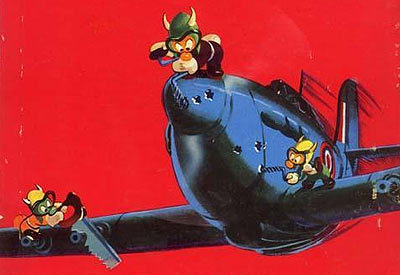
The gremlin specialization is obviously a mechanical one. Or, more specifically, the destruction thereof. Their motivations for such mayhem have been the target of much speculation over the years; some have said they match a pilot's mood (i.e. if a pilot's mood is dark, so shall his flight be, or if it is good, then all will be well, etc.). Some have theorized that it is simple pride, and if they feel as if they are insulted or laughed at, their chosen method of retaliation is the tampering or annihilation of property.
The etymology of the word “gremlin” is murky. Some say it derives from the Old English greme or gremian, meaning to vex or annoy, which was then coupled with goblin. But there are other plausible explanations. In Irish Gaelic gruaimin can mean “ill-tempered little fellow.” The German gramlein can be rendered into something like “a small bit of grief.”
Honestly, gremlins are quite the fascinating cousin to all goblin-kind, and I find myself regretting skipping over them when I was younger. The meagre research I've done over the past few days has actually resulted in much, much more than I could hope to squeeze into a single post.
I apologize, cousins. I never gave you the credit you deserved.
So! In closing:
Gremlins are
Proud
Extremely colourful
Enemies to machines of all types
Comfortable in, and protective of the sky
Incredibly sneaky
Incessantly talkative
Pack animals
Vicious
No friend to humans
As a bit of a silly afterthought, I feel the need to bring up a conversation I had with someone recently about gremlins, and how they were compared to a beaver's innate compulsion to stop flowing water. Except with them, it's machines and technology.

#gremlins#gremlincore#gremlin aesthetic#big gremlin energy#goblincore#goblin culture#goblin community
21 notes
·
View notes
Text
Werner Voss - Part 2
When Voss returned to the front in May, the playing field was more level. Before this, German aircrafts were far superior to British and French ones. Now, the Entente had improved aircrafts, such as the SE5, which could more than compete with the German Albatros D.III and D.V. Voss shot down his first SE5 on May 7th, 1917. He continued scoring during early summer and his reputation as one of the best fighter pilots alive (bested only by Manfred von Richthofen) was established.
An interesting aspect of Voss´s personality was that he was not limited by rank. In the German army (as with most armies of the time), officers usually did not consort with the lower ranks. Voss was an officer, and one who had received the highest award possible, but he distanced himself from the circle of COs. Instead, he spent a lot of time with mechanics he had befriended and helped repair his own airplanes. His youth and middle-class upbringing most likely influenced this behavior. One of his past times was working on and riding his motorcycle.

Voss’s behavior was somewhat controversial. It is suspected that he fell foul of several higher ranked officers because he had trouble accepting the authority of those he disagreed with. He even tried to get his CO removed because he thought the man was not daring enough and unworthy to lead as venerated a unit as Jasta Boelcke. Voss was subsequently appointed Staffelführer of Jasta 5. Here again, speculations come up about Voss being purposely held back to let Richthofen be the shining star, but this should be dismissed as unfounded rumors spread by people who dislike MvR.
Though Voss was by his own admission no great leader, he did well in Jasta 5. With his colorfully painted Albatross D.III, he patrolled over the lines, raising his victory score to 30 by June.
On June 28th, 1917, Voss became Staffelführer of Jasta 29. But this only lasted five days as he was called by Manfred von Richthofen to take over Jasta 14 and then Jasta 10 of JG1, Richthofen’s famous Jagdgeschwader. Again, Voss had trouble adjusting to his commanding role. All he wanted to do was fly and fight, not do administrative work more than anything else. So, he appointed an assistant to do that for him.
During the summer of 1917, Voss continued to score victories without sustaining any injuries. By the end of August he had added eight more, bringing his total to 38.
At the end of August, Voss went on leave again. After a close call with a British pilot which he barely escaped, Voss is said to have been very stressed and nervous. After spending a few days at home in Krefeld, he visited the Fokker Flugzeugwerke in Schwerin to test-fly a new model. Upon his return, he would add ten more victories to his score before his luck finally ran out.
His demise is famous across nations. His skill and tenacity are mentioned whenever war aviation is the topic.
On September 23rd, 1917, Voss set out on a hunt for enemies by himself. Soon he shot down a bomber plane, killing the two occupants. It was to be his final victory. He returned to his airfield, greeted by his two brothers who had come to visit. They ate lunch and took a picture together, the last one of Voss alive.
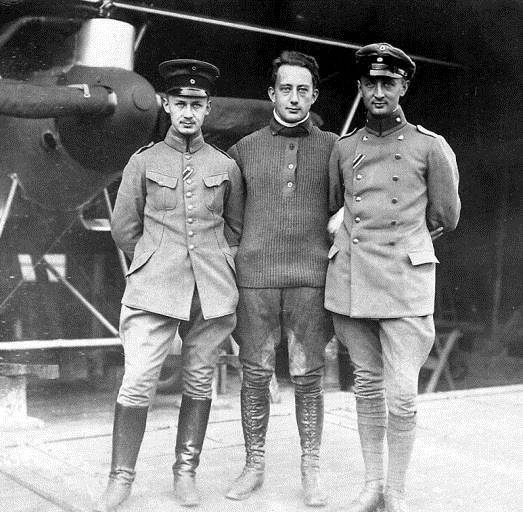
At around 5 p.m. Voss took off again on his final patrol. He was with other pilots from the unit, but Voss was able to climb quicker than the rest and his comrades soon lost sight of him. Meanwhile, on the other side of the lines, the British 56 Squadron went up with the same intentions as Jasta 10. Inevitably, the parties met and engaged in the greatest air battle of WWI. It is still unclear what is truth and what is fiction of the many retellings of this fight. But one thing is clear: Werner Voss saw the enemy aircraft far outnumbering him and instead of turning around, he confronted them head-on and was able to damage every single plane before being killed. After around 10 minutes of intense fighting with at least six enemies, Voss's airplane reportedly dropped suddenly and crashed.
His death was attributed to Arthur Rhys Davis, though there is still some doubt as to who was truly responsible.
Voss’s final fight is an interesting contrast to one of Richthofen’s. MvR and several comrades encountered a lone enemy, but instead of them all attacking him, only Richthofen fought while his comrades held back and ensured no other enemy pilot approached. If only the British had acted that way in Voss’s last fight.
"I shall never forget my admiration for that German pilot, who single handed, fought seven of us for ten minutes . . . I saw him go into a fairly steep dive and so I continued to watch, and then saw the triplane hit the ground and disappear into a thousand fragments, for it seemed to me that it literally went into powder." James McCudden
"His flying was wonderful, his courage magnificent and in my opinion he is the bravest German airman whom it has been my privilege to see fight." James McCudden
"If I could only have brought him down alive..." Arthur Rhys Davis
He was buried where he crashed but subsequent fighting in the area quickly made it impossible to find his grave. He is honoured on the wall of the Soldatenfriedhof at Langemark.

RIP Werner Voss (1897 – 1917)
Sources:
September Evening: The Life and Final Combat of the German World War One Ace Werner Voss, by Barry Diggens 2003
Unter the Guns of the German Aces, by Norman Franks and Hal Giblin 1997
My thanks to @ivy-and-edelweiss for proof reading and correcting my terrible grammar when neccessary!
25 notes
·
View notes
Text
Richthofen as leader and comrade (by Leutnant Friedrich Wilhelm Lübbert, Jasta 11)
My joy and pride were great when I received the news in December 1917 that Rittmeister von Richthofen had asked me to come to Jagdstaffel 11. So now I shall come into close personal contact with him, the role model of all German fighter pilots. Until then, I had only met him briefly at the memorial service of my brother who was at Jasta 11 when he died, and I only admired him as the famous pilot. Soon I would come to know and love all his wonderful and human qualities.
Richthofen was an aviator through and through. He became one of the most popular men in Germany. One would have thought that with such exposure to one of the most strenuous activities there is, and with the great popularity he enjoyed, there would be no room left for friendship and camaraderie. The opposite was true. For his officers Richthofen was as good a leader as a comrade. He played field hockey with us when we weren´t flying and oftentimes participated in our card games. We could approach him with every question and every concern and were sure to find sympathy and help.
As a teacher, Richthofen was unsurpassable. I was at several different units and at the fighter flying school: not once have I met a teacher who was able to convey the theory of dogfighting as clear as Richthofen. At all times he was ready to answer our questions. He approved of the inquisitiveness of his pilots. He never got impatient, no matter how simple and amateurish our questions were. With the utmost patience he took care of us. Every fresh pilot who joined his Staffel had to fly alone with Richthofen to the front. Afterwards the details of what happened were discussed.
Richthofen was very firm on one point: he only tolerated pilots in the squadron who really achieved something. He observed the beginner for some time; if he then came to the conclusion that the person in question did not meet the requirements Richthofen had for a fighter pilot, be it moral or technical ones, then he was certainly dismissed. But that was precisely the good thing for us, that everyone was sure to be judged by Richthofen not on external grounds but merely on his performance.
As leader Richthofen was loved by everyone. The men, especially the mechanics who generally were very close to their pilots, loved and worshipped him above all. That such a man also had a great connection to his officers was self-explanatory. Admirable was the composure with which he always treated the officers, even at times when he must have been very agitated on the inside. Of the many evidences of this experienced by all of us who were privileged to serve under him, I would like to cite the following: The squadron was returning from a frontline flight. The Rittmeister landed second to last. His brother Lothar hadn´t returned yet. When Richthofen landed, his first question was: "Is Lothar back?" Answer: "No, but it has been observed that at an altitude of 5,500 meters the top deck of his triplane flew away and that he glided downwards. Richthofen calmly walks with the pilots to the start house. No news has arrived there yet. Suddenly the telephone announces: "Lieutenant von Richthofen has crashed near Cambrai and is dead. Immediately afterwards the second message came in: "Lieutenant von Richthofen has made an emergency landing and has been seriously injured in the eye. Nobody knows which report is right. Depressed mood for everyone. The Rittmeister's features don't change one bit. "We'll have to wait and see," he says, calmly beginning with his criticism of today's flight. "By the way, I shot down two today," he says casually. When no further news came for a long time, he got into his machine and flew to the crash site to find out more about his brother's fate himself, whose injuries luckily turned out to be relatively minor despite the serious crash.
Despite his exhausting work as fighter pilot, leader and teacher, Richthofen never neglected his intellectual and sporting interests. In the evenings he often read, besides serious literary fiction also a lot of scientific literature. Sometimes I even saw him studying geographical or astronomical works, and I wondered how he is able to do that after a strenuous day.
He was never without anything to do. When he wasn't flying, he was doing target practice or going on horseback rides, something he felt compelled to do as a former passionate cavalryman. Or he went hunting, where he was able to take down impressive game, just like he spent most of his leave hunting.
If Richthofen was the best superior, teacher, comrade and friend we could wish for, he was also an unrivaled role model for all of us as a fighter pilot. He had all the qualities a successful fighter pilot needs: good flying, good shooting, seeing everything, staying calm and attacking with confidence. All of these qualities came together perfectly in Richthofen like no other fighter pilot. He was an enemy of unnecessary capers in the air – he never in his life did loop-de-loops for fun - and never pursued an unhealthy ambition that has cost the lives of many other good fighter pilots. "Slowly, but steadily," seemed to be his motto. "It's better to shoot down one fewer than to be shot down myself, because then I can no longer serve the fatherland." When his squadron or fighter wing was involved in an air battle, he saw everything and everyone. Not only did he deal with his own opponent, but he also monitored his pilots at the same time, either to help them in time or to be able to tell everyone afterwards when they were criticized how they shouldn't have done it.”
Rittmeister von Richthofen is no longer with us. But his immortal spirit lives within us all. He will remain the guiding star of German fighter aviation in eternity.
20 notes
·
View notes